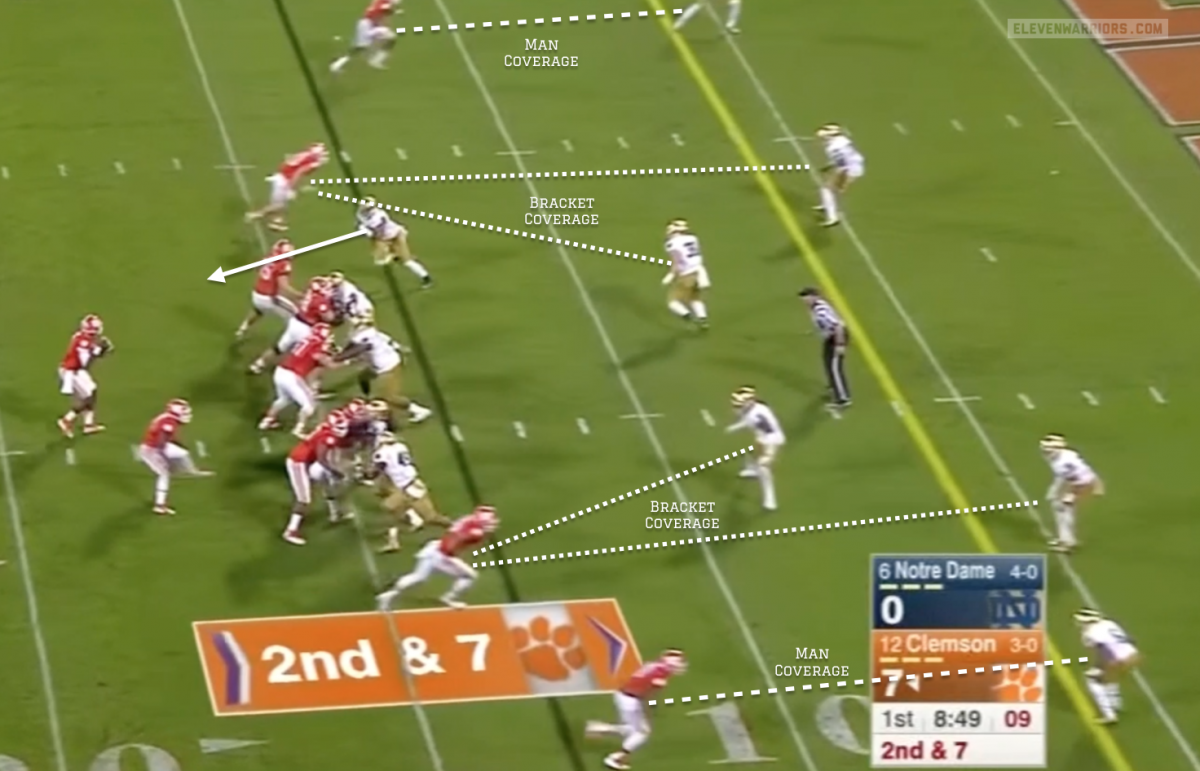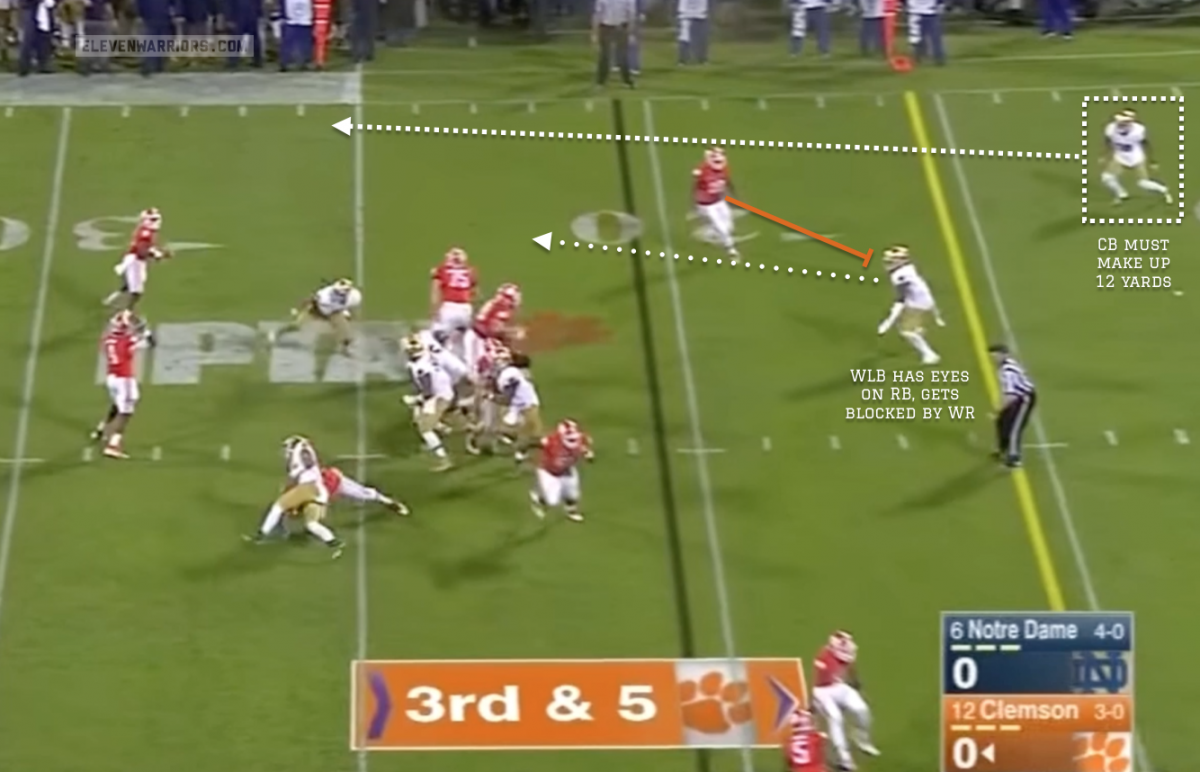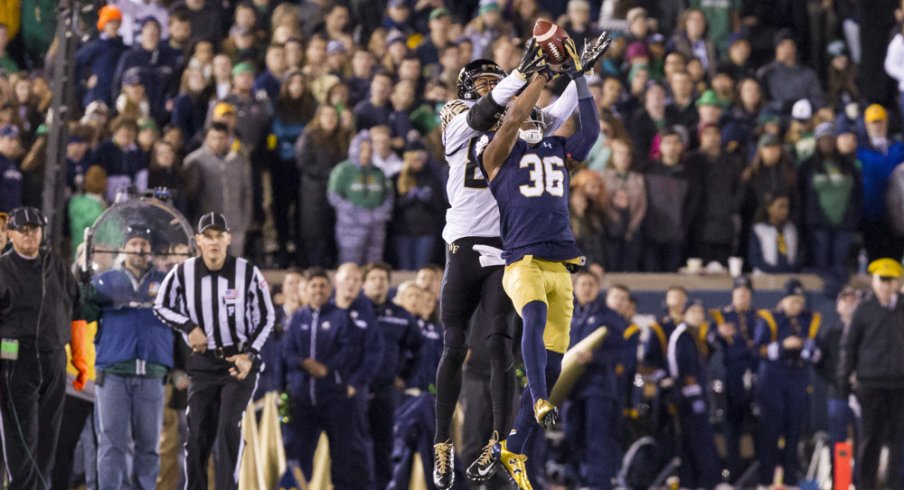Playing defensive back for Notre Dame is not an easy task these days.
With coordinator Brian VanGorder asking his entire front seven to be involved in stopping the run, members of the Fighting Irish secondary are often left to fend for themselves in coverage. Even with zone calls regularly coming from the sidelines, the back end of the Irish defense is often tasked with covering opposing receivers one-on-one downfield thanks to all the eyes in the opposing backfield.
With a great deal of NFL experience on VanGorder's resume, it's not surprise that he calls for a variety of concepts from his defense instead of doubling down on one style or philosophy, as is often the case at the college level. The varied styles seen each year on Notre Dame's independent schedule certainly make this approach more attractive, yet the results leave much to be desired.
Though the Buckeyes haven't been particularly reliant on their passing game much this fall, they can't plan on simply running the ball if they hope to win Friday's Fiesta Bowl. The Irish will almost certainly look to take away the run first, much as they did against Clemson in their close October road loss.
With seven pairs of eyes in the backfield, the ND secondary is often locked up in some version of man-to-man coverage. The unit will rotate between Cover 1 (straight, man-coverage with a deep safety in centerfield) against three-receiver sets, and Cover 4 (Quarters) when facing four wideouts.
Both looks can leave the Irish corners exposed, however. In Cover 1, vertical routes on the outside put the corners on an island, as the free safety is unable to get over and help along the sidelines.

To combat such deep balls, the Irish will mix in a fair dose of Cover 3, allowing the corners to bail early on and get depth to take away those home run shots. Yet that approach can open up the Irish edges to the same weakness as when they're in Cover 4.
In that look, all four defenders are lined up at even depth about 10 yards back from the line of scrimmage. Given that the Irish rarely use their 'Nickel' (five defensive backs) personnel, the Irish inside linebackers will help the safeties take away any crossing routes from the inside receivers.

Both strong safety Elijah Shumate (#22) and free safety Max Redfield (#10) are above-average in coverage compared to many other safeties at this level, often keeping the production of opposing slot receivers and tight ends to a minimum. Yet the Irish corners are once again exposed in this look, as they have no help over the top and are forced to give up most underneath curl, slant, and out routes.

For a receiver like Michael Thomas, who excels at deceiving defenders with his route-running ability, this matchup should be warmly welcomed. Making matters worse for the Irish, their top cornerback, KeiVarae Russell, will miss the game with a stress fracture in his lower leg, placing a great deal of pressure on juniors Cole Luke (#36) and new starter Devin Butler (#12). The Buckeyes haven't always made it a point to get Thomas the ball in such situations, but they'll certainly have the opportunity to do so in Glendale.
With those corners occupied by the outside receivers, they leave the flats unaccounted for, forcing the inside linebackers to cover wide swaths of field. Nearly every opponent has made a habit of stressing this facet of the Irish defense, especially to the wide side of the field where middle linebacker Joe Schmidt is the responsible defender.
Some teams have used bubble screens to draw Schmidt out to the flat, creating a foot race that should favor nearly any slot receiver. Texas optioned Schmidt in a run-pass option in the example below, allowing the quarterback to read whether he plays the inside handoff or the screen before deciding where to direct the ball.

With both outside defenders playing man-coverage, they're not watching to see the screen coming their way. Schmidt is outrun, forcing the safety to make the tackle after a 10-yard gain.
However, inside screens from that third-most inside receiver have worked as well, such as this tunnel screen that went 83 yards for a touchdown.

The most popular way though to attack the Irish linebackers has been with backs leaking out into the flats on designed flare routes. With the linebacker often playing a version of man-coverage on the back, letting them release to the flat and create a one-on-one matchup with the defender is one the offense will gladly take. USC hit their running backs on such patterns nine separate times that night, a major reason why the Trojans racked up more passing yards than any Irish opponent with 440.

Sometimes offenses will set up the flare as a designed screen, waiting for the corner to bail in Cover 3 or 4, or simply follow the receiver in Cover 1 as they block the inside linebacker responsible for the back.


Screens like these are so effective against the Irish because they're forced to bring a blitz in order to create any pass rush. The Notre Dame defense tallied only 22 sacks in the regular season, good for 82nd nationally, ten of which came against Texas, Pittsburgh, and Wake Forest.
As mentioned last week, VanGorder's arrival in South Bend two seasons ago prompted a major change in philosophy from the 3-4 scheme implemented by his predecessor, Bob Diaco. While there is no one superior philosophy to another, it's hard for it to succeed without the right players, something VanGorder is still looking to find.
Many of his defensive linemen, including star tackle Sheldon Day, are built to be run-stuffing, block-occupying 3-4 defenders. Only end Romeo Okwara, the team's leading sack-artist with nine, looks the part of a lean, quick pass-rusher.
To make up for this lack of natural pass rush, VanGorder is forced to bring additional rushers, often in the form of Schmidt or SAM linebackers James Onwualu (#17) and Greer Martini (#48).

VanGorder likes to bring this pressure from all angles, and we can expect him to try hard to confuse the right side of the OSU line where there have been issues in pass protection. However this pressure should immediately signal a 'hot' read for quarterback J.T. Barrett, perhaps on a flare route to Ezekiel Elliott from the backfield.
Elliott will undoubtedly be a big part of the game plan in his final game wearing a Buckeye uniform, but it may not be quite the way many expect. His presence in the OSU passing game has often been overlooked this fall, but he ranks third on the team with 26 receptions, and excels at running the same flare routes that have burned the Irish recently.
Those hoping for a big game from 'H' receivers Braxton Miller or Curtis Samuel may be in for a bit of disappointment, as the Irish rarely give up big plays to slot receivers in their defensive scheme. However there are plenty of plays for the Buckeyes to make on the edges, as long as they look for them.
Thanks to some roster issues due to injury and scheme, the Buckeyes should have far more talent on the field when they have the ball in this year's Fiesta Bowl, even though the Irish feature the Butkus Award-winning Jaylon Smith. But in addition to talent, OSU's offensive scheme should attack all the weaknesses of the Notre Dame defense, with a running quarterback in Barrett, and the ability to stretch the field horizontally to minimize Smith's effectiveness at linebacker.
With a full month to prepare and coming off a big outing against Michigan in their last game, we have every reason to expect an impressive showing in the Buckeyes' final performance.


